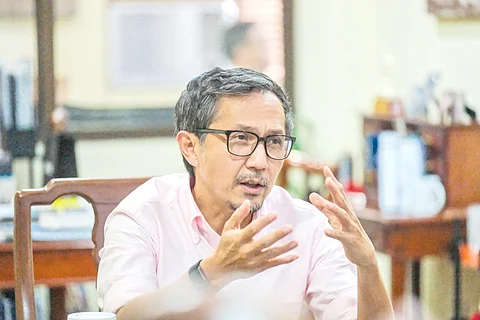
- NEWS
- the EDIT
- COMMENTARY
- BUSINESS
- LIFE
- SHOW
- ACTION
- GLOBAL GOALS
- SNAPS
- DYARYO TIRADA
- MORE

Interest in taking over the operations and maintenance of Metro Rail Transit Line 3 (MRT-3) is gaining traction, as the build-lease-transfer (BLT) contract with the Sobrepeña-led Metro Rail Transit Corp. (MRTC) nears its expiration later this year.
In an interview with daily tribune’s Straight Talk on Wednesday, Transportation Secretary Vince Dizon said that recent improvements in operations and rising commuter demand are drawing renewed attention to the line.
“The (expiring contract) has nothing to do with the current operations. We want to privatize it, and the Japanese and the MVP (Manuel V. Pangilinan) Group want to submit (a bid). I spoke to them a couple of weeks ago,” Dizon said.
The MRT-3 is government-operated, while its design, construction and maintenance are handled by the MRTC under a build-lease-transfer (BLT) agreement.
When the contract ends, the government will assume full ownership of the train line’s assets.
MRT-3, which spans 13 stations through Quezon City, Mandaluyong, Makati and Manila, was originally designed to carry over 23,000 passengers per hour per direction, with a capacity to expand to 48,000.
In previous years, Metro Pacific Investments Corp. — the majority stakeholder in Light Rail Manila Corp. which operates LRT-1 — was among the private firms that expressed interest in taking over the aging MRT-3 system.
However, unresolved issues over fare regulation and approval stalled prospects for private sector participation.
Still, Dizon noted that there has been a renewed interest in bidding for the MRT.
As the P8.7-billion reconstruction of EDSA starts, the Department of Transportation (DoTr) aims to keep MRT-3 operations uninterrupted.
To help ease commuter congestion during the ongoing roadwork, Dizon said the DoTr is awaiting clearance to deploy three additional MRT-3 trains, each capable of carrying 1,200 passengers.
“If you use all the trains, it would be okay, but not all the trains are cleared by Sumitomo. We can add three more but not yet. It would add 1,200 passengers per train,” he said.
Dizon noted that the MRT-3 system has made significant progress in efficiency and passenger experience. He cited improvements in queuing time, attributing the faster boarding to revised security protocols.
Although restrictions on luggage and boxes have been lifted, safety measures remain in place.
“The queuing gains are tremendous. (During the Aquino administration), queuing time was one hour, during (Secretary Arthur Tugade’s time), it was long. When I took over it was still 30 to 40 minutes. Now you will be shocked, it’s down to three to five minutes,” he said.
Removing X-ray cuts wait times
If you’ve recently taken the MRT-3, you may have noticed something surprising – the lines are moving a lot faster.
Dizon said that’s no accident.
In an interview on DAILY TRIBUNE’s Straight Talk, he revealed that removing the X-ray machines from key MRT-3 stations has dramatically cut the waiting times for commuters — from as long as 45 minutes (and at times over an hour) to just five to ten minutes.
“When I rode the MRT from Taft last March, it took me 30-plus minutes just to get in line. They told me it even reaches 45 minutes during rush hour,” Dizon recalled. “But now, after a month of implementing changes, the wait is down to five minutes — ten at most. It’s shocking.”
The change started as a pilot at two of the system’s busiest terminals: Taft Avenue and North EDSA. After personally experiencing the long queues, Dizon said he was prompted to rethink how security was being done.
He asked: why do commuters in Metro Manila have to undergo X-ray screening, when that’s not even the norm in train systems across Asia, Europe, or the US?
“Nowhere else in the world do you line up for an X-ray to ride the train,” he said.
Of course, not everyone was on board with removing the machines — some raised concerns about security. But Dizon assured the public that safety hasn’t been compromised. Instead, it’s being handled smarter.
Here’s how: nearly 200 uniformed security personnel, including heavily armed Philippine Coast Guard members, are now deployed across stations to act as a strong visual deterrent. On top of that, MRT-3 has tapped the Coast Guard’s K-9 facility in Clark, Pampanga, which trains hundreds of dogs capable of sniffing out explosives, drugs, and firearms. These K-9 units now patrol the stations in place of the X-ray machines.
Only large bags and boxes will need closer inspection; small bags can now pass through hassle-free. Metal detectors are still in place, and more tech upgrades are coming too — including AI-powered surveillance cameras, thanks to a partnership with the Department of Information and Communications Technology.
The result? Smoother entry, faster boarding and less stress.
“This is a huge help for our commuters,” Dizon said. “Time is precious. If we can save people 30 minutes to an hour each day, that’s a win.”
